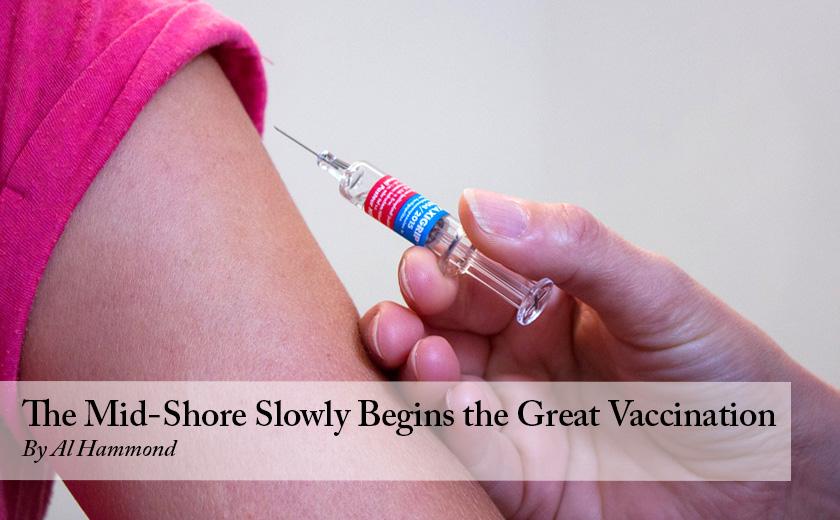The last two weeks of 2020 marked the effective start of vaccine administration for the Eastern Shore. Two different vaccines are in play: The University of Maryland’s Shore Regional Health hospital in Easton is administering the Pfizer/BioNTech vaccine, because they have the specialized sub-zero freezer required to store it; County health departments in Talbot, Caroline, Dorchester, Queen Anne, and Kent counties are administering the Moderna vaccine. Under Maryland’s distribution plan, both are focusing in Phase 1A on medical staff, nursing home residents, and first responders. All of those also have to have a second shot of the vaccine, 3 or 4 weeks after the first.
Because week to week deliveries of vaccine are still uncertain (Thank You, Operation Warp Speed not!), no one is certain how long phase 1A will last, but the best guess of county health officers is that phase 1B—people over 65 and those with underlying conditions that make them especially vulnerable—won’t start until about the third week in January, or maybe slightly sooner in smaller counties. And under Maryland’s plan, Phase 1B recipients will have to register online before they can get the vaccine, which will add delays and be difficult for those without internet access. So Phase 1B—which could include nearly a third of the population on the Eastern Shore, will last likely a month or more, even with adequate supplies of vaccine. Then Phase 2 (essential workers) and later still Phase 3 (general public) will get vaccinated.
Delays aside, the vaccines themselves are good news. Both the Pfizer and the Moderna vaccine are based on new technology (so-called messenger RNA vaccines). Your body uses RNA to messenger genetic instructions from your genes (DNA) on how to make proteins that your body needs. So unlike traditional vaccines based on weakened versions of the infectious agent, RNA vaccines don’t use the covid virus itself at all. Instead they consist of genetic instructions that allow your body to manufacture a protein that resembles the part of the virus (the spike) that attaches to human cells. That protein triggers your immune system to produce antibodies to fight the virus, protecting you if you were to become infected. The RNA vaccine itself—once it has delivered the genetic instructions—disappears from your body. So it’s impossible to catch the virus from the vaccine.
Moreover, RNA vaccines represent a new era of vaccine development. Moderna, for example, has been working in partnership with the US National Institutes of Health for several years on RNA vaccines. So when the CEO of Moderna received an email containing the genetic code for the virus, just a few days after the first Covid death in China, he immediately sent it on to his partners at NIH and proposed that they use their new RNA technology. Within 3 weeks, the Moderna/NIH scientists had created a candidate vaccine, and within 6 weeks they shipped the first samples to begin clinical testing—an unprecedented timescale. Scientists believe it is likely that, in future, RNA vaccines will be developed that protect against multiple diseases (by delivering genetic instructions for several different proteins) with a single shot.
Other vaccines are on the way. The J&J vaccine candidate, not yet approved, is a traditional weakened virus vaccine, but will require only a single shot. The Oxford/AstraZeneca vaccine is also a weakened virus vaccine, already approved in Britain, which doesn’t need refrigeration and is inexpensive to make. Still other covid vaccines are in development, including one based on injecting a protein (similar to the flu vaccine) by Novavax, a company based in Maryland.
Regardless of the type of vaccine, it takes several weeks before protection is fully effective—and that means several weeks after the second shot for Moderna and Pfizer vaccines. During that period, you could still become infected and could still transmit the virus to those around you. So even after you get your first shot, plan on wearing a mask and practicing social distancing for two months more. Moreover, covid cases are surging, and the impact of Christmas/New Year’s travel and gathering still to come. So January promises to be the most dangerous period of this pandemic, with hospitals and healthcare workers overwhelmed. Not a time to take risks.
Al Hammond was trained as a scientist (Stanford, Harvard) but became a distinguished science journalist, reporting for Science (a leading scientific journal) and many other technical and popular magazines and on a daily radio program for CBS. He subsequently founded and served as editor-in-chief for 4 national science-related publications as well as editor-in-chief for the United Nation’s bi-annual environmental report. More recently, he has written, edited, or contributed to many national assessments of scientific research for federal science agencies. Dr. Hammond makes his home in Chestertown on Maryland’s Eastern Shore.



Write a Letter to the Editor on this Article
We encourage readers to offer their point of view on this article by submitting the following form. Editing is sometimes necessary and is done at the discretion of the editorial staff.